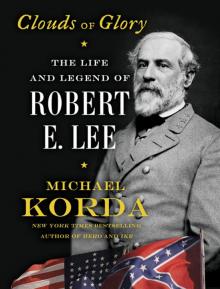- Home
- Michael Korda
Clouds of Glory Page 44
Clouds of Glory Read online
Page 44
It is a sound military maxim (sometimes attributed to George Patton)* never to pay twice for the same piece of real estate, but it may be that McClellan’s nerves were rattled—he had not seen combat up close since the Mexican war and had a kind of gloomy premonition that Lee was preparing to attack him. In any case McClellan might have done better to leave matters at Oak Grove in Heintzelman’s hands. Though not a particularly gifted commander, Heintzelman was the man on the spot and perfectly competent to command three brigades without the help of the commander in chief of the army. Federal artillery north and south of the Chickahominy began a fierce bombardment to support Heintzelman, and the sound could be heard clearly seven miles away in Richmond.
Puzzled and anxious, Lee rode forward in the mid-afternoon to see for himself what was happening, and concluded at once that the Federal attack was being held and, more important, that it remained “local” for the moment—that is, it was not going to be supported by McClellan’s other corps south of the Chickahominy this afternoon.
Lee made the “audacious” decision not to postpone his own attack, scheduled for the next day. One of President Davis’s aides, who had served briefly with Lee, when asked what the new commander of the Army of Northern Virginia was like, replied, “If there is one man in either army, Federal or Confederate, who is head & shoulders, far above every other one in either army in audacity that man is Gen. Lee. . . . Lee is audacity personified. His name is audacity.” This was not how Lee was viewed by most people at the time, but it was correct. Almost any other commander would have postponed his attack at least long enough to see what the enemy was doing and prepare for what might, after all, become a general assault against the Confederate right toward Richmond the next day, of which Heintzelman’s attack at Oak Grove was merely the first move; but Lee decided that his own attack would shake McClellan’s nerve, so long as he kept his own.
Lee’s instincts served him well. By early evening the Union attacks and the volume of Union gunfire began to peter out. Though Lee could not have known it, McClellan had received reports throughout the day that Jackson’s army had vanished from the Valley and might be on the move toward him, and about the same time that Lee reached Nine Mile Road to observe the battle at Oak Grove, McClellan left it to hurry back to his headquarters, where an urgent message from Major General Fitz John Porter, commanding the Union line north of the Chickahominy, stated that his cavalry pickets were being pushed back, and that “a fugitive slave” from Richmond had described the arrival of fresh troops in the city, who had been greeted by cheering crowds. McClellan “took counsel of his fears” and drew the wildly incorrect conclusion that he was now facing between 150,000 and 200,000 Confederate troops, though in fact, even including Jackson’s 18,500 men still on their way and the 21,000 men holding the lines that Lee had dug around Richmond, the Confederates had a total of only 85,000. He also drew the correct conclusion that Jackson intended to turn his right north of Beaver Dam Creek. By that time the transfer of Jackson’s army from the Valley to Richmond was an open secret. On June 25 Mrs. Chesnut, always well informed, noted it in her diary, having learned about it far away in Columbia, South Carolina: “Stonewall is coming up behind McClellan—and then comes the tug of war,” she wrote. In the circumstances, McClellan decided to break off the fight before Seven Pines, just as Lee had guessed he would.
Lee’s audacity had paid off. Had McClellan chosen to take advantage of Heintzelman’s attack to push the corps on either side of him forward, he might indeed have been in Richmond the next day, as President Davis had always feared—there was nothing in front of him but two divisions. Instead he returned to his headquarters to write a blistering letter to Secretary of War Edwin M. Stanton: “I regret my great inferiority in numbers, but feel I am in no way responsible for it. . . . I will do all a general can do with the splendid Army I have the honor to command & if it is destroyed by overwhelming numbers I can at least die with it & share its fate.” Since he had observed the Battle of Oak Grove in perfect safety from a redoubt in Heintzelman’s lines the last sentence quoted is not only overwrought but also a useful indication of McClellan’s incredible narcissism, and hints of a persecution complex bordering on paranoia.
For all that, he was a very capable soldier—even Lee, when asked after the war who was the ablest Union general, replied, “McClellan, by all odds.” Nobody was better at training an army, or keeping it deployed, or anticipating the enemy’s intentions than McClellan. Even before he wrote his letter to Stanton with the operatic suggestion that he expected to die at the head of his troops, he was already giving orders to start moving his base of supply by ship from the York River to the James River, anticipating that Lee intended to cut his lines of communication to White House and West Point. McClellan’s problem was not that he lacked courage or skill; it was that he excelled at building up an army that was neat, tidy, disciplined, and equipped in every detail, and having done so he could not bear to see it destroyed.
As for Lee, he rode back to Richmond as the sun began to set. It had been raining all day, but just as the rain stopped, the clouds parted, and behind him there appeared a rainbow, an omen celebrated in a poem by John R. Thompson:
There our army—awaiting the terrible fight
Of the morrow—lay hopeful, and watching, and still;
Where their tents all the region had sprinkled with white.
From river to river, o’er meadow and hill . . .
When lo! On the cloud, a miraculous thing!
Broke in beauty the rainbow our host to enfold!
The centre o’erspread by its arch, and each wing
Suffused with its azure and crimson and gold.
Blest omen of victory, symbol divine
Of peace after tumult, repose after pain;
How sweet and how glowing with promise the sign,
To eyes that should never behold it again!
A tired gray man on a gray horse, riding thoughtfully back to the Dabbs house in the glow of a rainbow: this paints a dramatic picture, but whether or not Lee was aware of the augury in the sky behind him is unrecorded. He had a lot on his mind. He had willed himself to put aside any personal concerns in view of the task before him, but his family was scattered, homeless, and in grief—his daughter-in-law Charlotte, driven from her home at the White House plantation and five months pregnant, had traveled to Jones Springs, North Carolina, together with three of Lee’s daughters, hoping that the “healing springs” would restore health to Lee’s only grandchild, Rob. But despite the “nice clean comfortable” surroundings the sickly infant died of what seems to have been pneumonia. Mary Lee was in Richmond, suffering more than ever from arthritis and the brutal summer heat, but Lee had not yet been able to take time off from his duties to see her.
9. The crude map of the vicinity of Richmond, used by the Confederate high command during the Seven Days battles of 1862.
{Robert E. Lee, Volumes 1, 2, and 3, by Douglas Southall Freeman, copyright © 1934, 1935, by Charles Scribner’s Sons, copyright renewed 1962, 1963, by Inez Godden Freeman. All rights reserved.}
Lee was also concerned, with good reason, that his plan for tomorrow was too complicated. His written order had been drafted with care, but on rereading it seems very hard to follow. Jackson’s copy was followed by an additional and even more confusing letter about the approaches to Beaver Dam Creek: “The four divisions,” his order ran, “keeping in communication with each other and moving en echelon on separate roads, if practicable, the left division in advance, with skirmishers and sharpshooters extending their front, will sweep down the Chickahominy and endeavor to drive the enemy from his position above New Bridge, General Jackson bearing well to his left, turning Beaver Dam Creek and taking the direction toward Cold Harbor.”
The phrase “if practicable” was to become familiar in Lee’s orders, and it led to many unfortunate consequences, since it provided subordinate commanders with a kind of escape clause, allowing them to argue after the event t
hat what they had been ordered to do was not, in their view, “practicable.” The phrase “separate roads” also raised all sorts of problems, particularly for Jackson, to whom this part of Virginia was unfamiliar, and who had unwisely left the indispensable Hotchkiss, his mapmaker, behind in the Valley. Lee’s attempt to further clarify matters for Jackson only compounds the confusion: “In your march tomorrow on reaching the Merry Oaks, the roads divide. By the map before me the right hand, called the Ash Cake road, intersects, near Mrs. McKenzies, a road leading to Shady Grove Church.” In the days when roads were largely unmarked by signposts, and when, as Walter H. Taylor remarks, “country people who were relied on as guides seemed to have no knowledge of such matters beyond the immediate vicinity of their homes,” this was an invitation to disaster.
Even the faithful Walter Taylor notes that the Confederate generals were hampered by “their ignorance of the country and lack of adequate maps.” This was a puzzling statement, since they were after all going to be fighting less than ten miles from their own capital, and one would have supposed that in the months since McClellan landed on the peninsula there had been ample time to prepare maps showing at the very least “the location of the roads.” Brigadier General Richard Taylor, in Destruction and Reconstruction, wrote somewhat waspishly of his fellow generals around Richmond, “The Confederate commanders knew no more about the topography of the country than they did about Central Africa.” He was not wrong. In fact McClellan had better maps of Richmond than Lee did.
Still, in the four weeks since Lee took command of the Army of Northern Virginia, he had performed miracles in preparing it for battle, while at the same time developing a complex, and ultimately successful, strategic plan for its use. Since much of what he had done was invisible to the general public, he was still a target of doubt and ridicule, but Davis understood it, and so did the generals who served under Lee—though even they, and for that matter even Lee himself, might not have believed that a man of his age was about to fight ten major battles in a single week, surely a record unequaled in military history.
The only way to understand the “Seven Days” is to regard it as one long battle, in which Lee constantly attacked the enemy. Some days he lost; other days he won; sometimes the two armies fought to a brief, bloody draw; but inexorably and untiringly Lee pushed McClellan’s larger army back until he had lifted the threat from Richmond.
On June 26 when Lee woke at dawn the weather was promising; but from first light on he was confronted by bad news from the field, beginning with a message from Jackson to say that his march had been delayed.
Jackson had given himself “less than forty-eight hours to get his divisions into position more than thirty miles away,” but after two nights without sleep he had lost the crisp power of command that compelled his men to march beyond their limits. On June 24 he waited for the rear units of his army to catch up “with the main body,” and seems to have been dazed with fatigue himself. That night he was found sitting up reading a novel while his uniform dried, apparently oblivious to the state of “confusion” of his army. His assistant adjutant general* was Major Robert L. Dabney, whom he had plucked from civilian life because of “his distinguished theological career,” an eccentric and unfortunate choice. Dabney had no military experience, let alone any enthusiasm for his job. Putting him in charge of moving 18,500 men merely because he was a “stimulating preacher and brilliant professor of theology” was placing altogether too much faith in God’s ability or willingness to perform miracles. Without Jackson’s constant presence and fierce concentration to back him up, Dabney dithered and failed: Soldiers straggled, the supply and commissary wagons lagged miles behind the troops; even sensible plans for watering the horses and giving the men a chance to fill their canteens were ignored.
By the end of the day Jackson’s army had marched twenty-two miles, an impressive feat considering that the roads were meandering muddy tracks rather than the straight macadamized surface of Valley Pike, and that the weather was hot, sultry, and humid, with occasional showers, hard marching for men who were used to the cooler air and higher ground of the Shenandoah Valley. The army encamped for the night six miles short of Ashland to the west of where Lee expected it to be at that point, and almost twelve miles from the Virginia Central railway that it should have crossed by now; and Jackson’s increasing irritability and short temper with his own officers were not helping matters. This was a bad beginning. In a note to Lee, Jackson drew his attention to the fact that enemy cavalry scouts had been driven back from Ashland and the telegraph wires near there had been cut, a sure sign that McClellan already knew Jackson was coming and what his route would be. The element of secrecy had been lost—in fact, the story the “fugitive slave” had told was now confirmed by a deserter from Jackson’s own army.
Jackson spent the night in a farmhouse and close to the railway line, just where his army should have been. During the evening he heard cheering as some of his men greeted the arrival of Brigadier General J. E. B. Stuart, whose 2,000 troopers were to guard Jackson’s left flank as he advanced the next morning. Their ride around McClellan’s army had made Stuart almost as great a military celebrity as Jackson, but he and Jackson must have made a striking contrast—Jackson in his threadbare, dusty, uniform and enormous muddy boots; Stuart with his plumed hat, impeccable gold-braided uniform, yellow sash, gauntlets, and gleaming top boots. The two men knew and admired each other despite the difference in their appearance: Stuart, underneath his Cavalier pose, was a deeply religious man, and religion was always a matter of importance to Jackson. But now Jackson was too tired for a long conversation, regrettably; since Stuart had found his way to Ashland easily enough, one would think he could have given Jackson useful advice about the way ahead. He does not seem to have pressed his assistance on Jackson, nor does Jackson seem to have asked for it. Stuart was a first-rate professional soldier; he knew exactly where Lee expected Jackson to be the next day and how to get there. He could surely have shed a good deal of light on Lee’s somewhat opaque letter, which Jackson was puzzling over. It may have been that Jackson did not think a major general should ask a brigadier general for advice, though that does not sound like Jackson, who always listened carefully to Hotchkiss, a mere captain. When two of his own brigadier generals—Richard Ewell and William Whiting—appeared at the farmhouse around midnight to urge that the army advance on two parallel roads once it crossed the Virginia Central railway track, in order to cut in half the time it would take to approach Hundley’s Corner, about two miles above the right of Porter’s lines on Beaver Dam Creek, Jackson nodded politely but did not commit himself. James L. Robertson Jr., author of a meticulous biography of Stonewall Jackson, states that when Ewell went back to the house to retrieve his sword, which he had left there, he found Jackson kneeling in prayer. Since Jackson had promised Lee the army would be “underway” by 2:30 a.m., and since he always rose before his soldiers and appeared fully uniformed and mounted as they formed up, he cannot have had more than an hour’s sleep that night. This was not good for a man of thirty-eight who had been on the move and without a decent night’s sleep since June 20.
10. Route of Jackson, Ewell, and Branch, June 26, 1862.
{Jackson’s route and Battle of Gaines’s Mill, by permission of Scribner Publishing Group, from Lee’s Lieutenants, Volumes 1 and 2, by Douglas Southall Freeman, copyright © 1942 by Charles Scribner’s Sons; copyright renewed 1970 by Inez Goddin Freeman, copyright © 1943 by Charles Scribner’s sons; copyright renewed 1971 by Inez Goddin Freeman. All rights reserved.}
Despite Jackson’s order, his troops were not in fact on the move until 8 a.m. on the morning of Thursday, June 26, and the vanguard did not cross the railway until 9 a.m., six hours behind schedule, at which point Jackson sent a message to Brigadier General Lawrence Branch, who according to Lee’s plan was supposed to cover Jackson’s right flank while Stuart’s cavalry covered his left. Stuart and his cavalry had been present since dawn, and for a good deal of the
day the two men rode together, but Branch was nowhere to be seen, although his brigade was intended to be the “connecting link” between Jackson and the rest of the Army of Northern Virginia. The countryside was oppressive, and the narrow roads ran between dense woods and impenetrable thickets of tangled brush. The Federals had destroyed many of the bridges, further delaying Jackson’s columns, and sniper fire, improvised barricades, felled trees, and creeks that had flooded their banks caused more delays. Jackson had accepted Ewell’s advice about advancing on parallel roads, though not before he prayed over it first, as Ewell remarked with somewhat malicious humor, but progress remained painfully slow.
There are two schools of thought about Jackson’s failure to keep to the schedule he had promised Lee. Supporters argue that Jackson was addled by exhaustion, and delayed by Major Dabney’s inability to get the men fed, provided with water, and moving on time. In addition, Jackson was hampered by his choice of Dabney’s brother, who claimed to know the area well, as his chief guide; and finally, fatally by the incompetence of Lee’s staff and the obscurity of Lee’s orders. Jackson, his supporters claim, tried to follow those orders to the letter but did not even understand that his attack was intended to be the signal for the other corps commanders to begin theirs. In short Jackson did not realize that the battle would not begin until he had passed Mechanicsville and turned Porter’s lines on Beaver Dam Creek.
Supporters of Lee admit that his staff was too small for a commander in the field, but point out that its competence—certainly that of those closest to Lee like Walter Taylor, A. L. Long, and Charles Marshall—was unquestioned. As for Lee’s orders, although they are possibly too detailed and specific, he had made his plan clear enough to everyone who attended the meeting on June 23. Unless Jackson was dozing during it, he must have been aware that Lee’s intention was to launch the entire attack as Jackson’s army appeared. The other generals at the meeting certainly understood exactly what Lee intended—hence Longstreet’s concern that Jackson was not giving himself enough time.

 Passing
Passing Another Life
Another Life Clouds of Glory
Clouds of Glory Hero: The Life and Legend of Lawrence of Arabia
Hero: The Life and Legend of Lawrence of Arabia Cat People
Cat People Hero
Hero With Wings Like Eagles: A History of the Battle of Britain
With Wings Like Eagles: A History of the Battle of Britain Ulysses S. Grant
Ulysses S. Grant